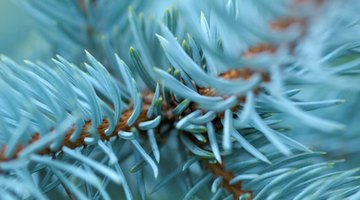How to Propagate Colorado Blue Spruce
The Colorado blue spruce, with its symmetrical shape and lovely bluish-green needles, is a majestic-looking tree that can soar to a height of 100 feet and attain a width of 30 feet. It makes a striking specimen tree and an effective windbreak, and is also used as a Christmas tree.

It's no surprise that gardeners like to try to propagate the Colorado blue spruce, but persuading the cuttings to take root can be a challenge. With the proper techniques and materials, you can increase your chances of successfully rooting your cuttings of this beautiful evergreen.
Things You Will Need
- Pruning scissors or pocketknife (optional)
- Rooting hormone powder
- Fine-grained sand, sterilized in an oven
- 2-inch pots
- Clear thick plastic bag
- 4-inch pots
- Potting soil
-
Select a live Colorado blue spruce tree from which to take your cutting. Choose a healthy tree with fragrant, dense needles, symmetrical shape and no diseases or pests. Never use a cutting from a Colorado blue spruce that has already been cut down for use as a Christmas tree.
-
Take a 6-inch cutting from the current season's growth, choosing a side shoot near the base of the spruce tree, in late spring to early summer. If possible, pull off the shoot manually--this usually causes a small spur of tissue, called a heel, to remain on the cutting. If removing the shoot from the spruce tree with a penknife or scissors, try to make sure a heel of bark is included at the base of the cutting to promote root growth.
-
Wound the cutting by making a 3/4-inch, V-shaped notch at the basal end of the cutting to stimulate absorpton of root-promoting chemicals. Snip off any needles that would come in contact with the growing medium.
-
Prepare the cutting using a dry powder rooting hormone in a concentration made for difficult-to-root woody-stemmed cuttings. Pour out enough powder for one-time use. Dip the end of the cutting one inch into the powder so that powder is distributed in an even layer about 1/16 of an inch thick over the base of the cutting. For better absorption of water and nutrients and uniform growth, make sure the powder is all around the base of the cutting. Don't let the rooting hormone powder touch the needles or any other part of the cutting. Discard any unused powder you have poured out of the container.
-
Tap the cutting gently to shake off excess powder, and immediately place it in a 2-inch pot of moist sand that you have sterilized by heating in an oven at 140 degrees for 30 minutes, and then allowed to cool. Make a hole in the sand so the powder is not scraped off, then apply enough water to make the sand settle around the cutting.
-
Put a clear plastic bag over the cutting to conserve humidity.
-
Place the cutting in indirect light, keep it at about 80 degrees and keep the sand moist. Rooting can take several months.
-
When the cuttings have two or three roots about a half-inch long, transplant them to 4-inch pots, in good-quality, well-drained potting soil. Don't expose the young Colorado blue spruces to direct sunlight or extreme temperatures for several weeks. When the spruce trees are 6 inches tall, you can plant them outside.
Tip
Record the location of the parent tree, the type of cutting, the procedures used and the time of year in a journal so you can duplicate your success with other blue spruce cuttings.
The Drip Cap
- The Colorado blue spruce, with its symmetrical shape and lovely bluish-green needles, is a majestic-looking tree that can soar to a height of 100 feet and attain a width of 30 feet.
- If removing the shoot from the spruce tree with a penknife or scissors, try to make sure a heel of bark is included at the base of the cutting to promote root growth.
- Pour out enough powder for one-time use.
- Rooting can take several months.
- When the cuttings have two or three roots about a half-inch long, transplant them to 4-inch pots, in good-quality, well-drained potting soil.
- Don't expose the young Colorado blue spruces to direct sunlight or extreme temperatures for several weeks.
References
Writer Bio
Carol Sarao is an entertainment and lifestyle writer whose articles have appeared in Atlantic City Weekly, The Women's Newspaper of Princeton, and New Millennium Writings. She has interviewed and reviewed many national recording acts, among them Everclear, Live, and Alice Cooper, and received her Master of Fine Arts degree in writing from Warren Wilson College.
Photo Credits
- detail of siberian silver spruce image by Tomo Jesenicnik from Fotolia.com
- detail of siberian silver spruce image by Tomo Jesenicnik from Fotolia.com
More Articles



